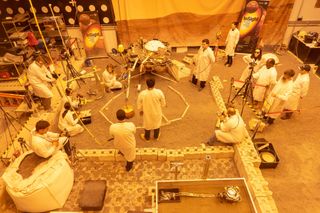NASA Builds a 'Martian Rock Garden' to Prep Moves for InSight Mars Lander

NASA's Mars InSight lander is gearing up to deploy its science instruments on the Red Planet. Here on Earth, InSight's twin spacecraft, ForeSight, has beat it to the punch.
InSight touched down on Mars on Nov. 26, and now the lander is beginning the meticulous process of unloading its various science instruments using a claw-like grappling tool that looks a lot like one of those frustrating "skill crane" machines you might find at an arcade. If you thought grabbing one of those 25-cent stuffed animals was tough, imagine trying to use that crane to relocate millions of dollars' worth of instruments on a planet that is millions of miles away.
Before tackling this delicate task on Mars, engineers at NASA's Jet Propulsion Laboratory (JPL) in Pasadena, California, are doing some practice runs on Earth. The team built an exact replica of InSight to test out the spacecraft's operations before sending commands to the lander on Mars. [Mars InSight in Photos: NASA's Mission to Probe Core of the Red Planet]
They not only built ForeSight as InSight's Earthly counterpart but also created a "Martian rock garden" to simulate InSight's landing site. The Martian rock garden was modeled after images from the InSight lander's onboard cameras.
Engineers even used augmented-reality headsets to project 3D images of the terrain onto the test bed, where they "raked, shoveled and patted down a bed of crushed garnet intended to simulate Martian sand," NASA officials said in a statement. "They call the shaping of this gravel-like material 'Marsforming.'"

The team meticulously sculpted the mock Mars terrain to make sure that not a single pebble was out of place. Any rock larger than 1 inch (2 centimeters) could pose a hazard to the instruments, so mission controllers chose a "boring" landing site to avoid any pesky pebbles and rocks.
"All around us, there are rocks that were ejected from nearby craters. These can be launched miles across the landscape, depending on the impact size," Nate Williams, a JPL postdoctoral researcher working on the InSight mission, said in the statement. "Thankfully, there just aren't a lot of rocks right in front of us."
Get the Space.com Newsletter
Breaking space news, the latest updates on rocket launches, skywatching events and more!
The first instrument InSight will deploy on the surface of Mars is a seismometer. Named the Seismic Experiment for Interior Structure (SEIS), the instrument will measure seismic activity, or "marsquakes," to help scientists learn more about the planet's interior structure.
Over the weekend, engineers used ForeSight to practice deploying the seismometer about 5.4 feet (1.6 meters) directly in front of the lander. InSight used its claw to pick up the seismometer on Monday (Dec. 17), and engineers plan to send InSight the command signal instructing it to place the instrument on the ground today (Dec. 19), NASA officials said. The team expects to receive images of the deployed seismometer in the next few days.
After it deploys the seismometer, InSight will have two more instruments left to grapple and relocate onto the Martian surface. The German Aerospace Center has an experiment on board called the Heat Flow and Physical Properties Package (nicknamed the "mole"), which will probe as deep as 16 feet (5 meters) below the Martian surface to measure heat flow in the planet's interior. That instrument will need to be placed about 4 feet (1.2 meters) to the left of the seismometer, NASA officials said.

The third instrument that will need to be placed on the ground is for a radio-science investigation called the Rotation and Interior Structure Experiment (RISE). It will use InSight's radio communication system to precisely track the lander's location, allowing scientists to measure how much Mars wobbles as it orbits the sun. This, too, will allow researchers to better understand the planet's interior.
InSight, whose name stands for Interior Exploration using Seismic Investigations, Geodesy and Heat Transport, will spend the next two years using those instruments to learn more about what lies beneath the surface of Mars and the composition of the planet's core. But it also carries some secondary instruments that can stay on board the lander.
One, called the Temperature and Winds for InSight (TWINS), will study the weather on Mars. Another instrument, the Laser RetroReflector for InSight (LaRRI), is not a part of InSight's science mission, but it will allow Mars orbiters to make precise measurements of InSight's location, enabling the orbiters to accurately measure distances and track the planet's movement.
Email Hanneke Weitering at hweitering@space.com or follow her @hannekescience. Follow us on Twitter @Spacedotcom and on Facebook. Original article on Space.com.
Join our Space Forums to keep talking space on the latest missions, night sky and more! And if you have a news tip, correction or comment, let us know at: community@space.com.

Hanneke Weitering is a multimedia journalist in the Pacific Northwest reporting on the future of aviation at FutureFlight.aero and Aviation International News and was previously the Editor for Spaceflight and Astronomy news here at Space.com. As an editor with over 10 years of experience in science journalism she has previously written for Scholastic Classroom Magazines, MedPage Today and The Joint Institute for Computational Sciences at Oak Ridge National Laboratory. After studying physics at the University of Tennessee in her hometown of Knoxville, she earned her graduate degree in Science, Health and Environmental Reporting (SHERP) from New York University. Hanneke joined the Space.com team in 2016 as a staff writer and producer, covering topics including spaceflight and astronomy. She currently lives in Seattle, home of the Space Needle, with her cat and two snakes. In her spare time, Hanneke enjoys exploring the Rocky Mountains, basking in nature and looking for dark skies to gaze at the cosmos.
